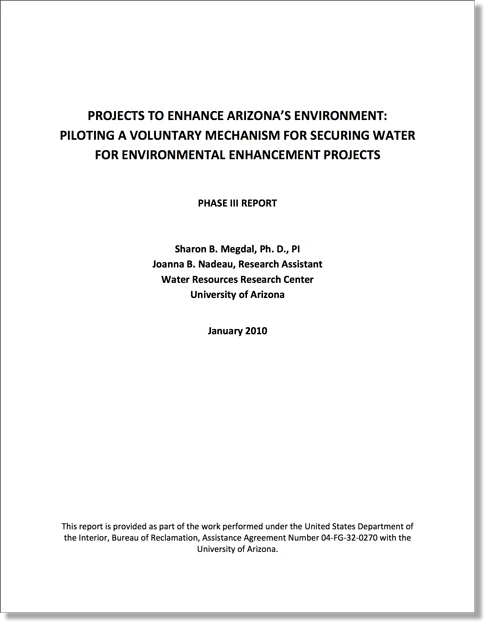
On April 6 the Water Resources Research Center held its annual conference. Titled “Water and the Environment: The Role of Ecosystem Restoration,” the conference provided a forum for learning about environmental enhancement in Arizona. Information, experiences and perspectives were shared, and restoration efforts were “showcased.”
Whatever word we use — restore, preserve, maintain or enhance — such projects are designed to improve an environment over and above what would have existed if actions had not been undertaken. But how do we decide which actions to undertake?
Opening keynote speaker Bill Dawson of the U.S. Army Corps of Engineers commented that cost-benefits analyses should not be the sole consideration of environmental restoration efforts. He also noted that it does not matter how we got to the degraded situation, but rather it is important to figure out how to fix it.
Fixing water quality problems is the focus of many restoration efforts nationally. In his overview of restoration projects, Cliff Dahm of the University of New Mexico documented the increase over the last ten to 15 years in river restoration projects in Arizona, the Southwest and indeed throughout the nation. By far, water quality management and riparian management were the two most prevalent purposes of these projects. Measuring the success of restoration efforts through monitoring is important. Julie Stromberg of Arizona State University focused on the question of assessing success through measuring ecosystem improvement and improved system resilience.
A public perception of success, however, also is important. The projects that possibly are most likely to touch the greatest number of people are along the Salt River in Maricopa County. After being rejected by voters in the 1980s, habitat improvement along the Salt River - Rio Salado has become a focal point of multiple jurisdictions and Indian Nations. Improvements are varied. Karen Williams of Phoenix spoke of the importance of restroom facilities, benches, and staging areas for teachers. She was hopeful that benefits would spillover beyond the banks to what are distressed areas of Phoenix.
In “The Cadillac Desert,” Mark Reisner spoke of these distressed areas: “Phoenix owes its existence to [the Salt River], but even so it doesn’t seem to hold the Salt in high esteem. On both banks, the floodplain is encroached by industrial parks, trailer parks, RV parks, but no real parks. The flood channel itself has been developed to a degree, playing host to establishments which are, by nature, transient: topless bottomless joints, chop shops, cock-fighting emporia. Paris built its great cathedral by its river; Florence its palaces or art; Phoenix seems to have decided that its river is the proper place to relegate its sin.”
Efforts are underway to remedy the remnants of the sad and dismal situation described by Reisner. These efforts, including Audubon Arizona’s new nature center at River and Central Avenue, have the potential to improve more than just the non-human environment.
Participants were upbeat and the event’s atmosphere was positive despite the general awareness that challenges associated with restoration efforts are substantial. A significant factor for all of these projects is water; water is needed to sustain environmental enhancement efforts. Questions remain about the water supplies or sources necessary to sustain some of these projects along with the long-term costs of water. My own study of environmental restoration efforts in Pima and Maricopa counties provided information on the substantial water requirements and costs of some of the projects studied.
To act early to develop partnerships and involve interested parties was underscored. These partnerships can take many different forms and often involve the private and public sectors. The need for monitoring and multidisciplinary research was clear, both at the front-end of projects as well as after projects are completed. The need for communication at many levels was apparent. Whether relating the reasons for spending millions of dollars on the Lower Colorado River Multispecies Conservation Program or for putting up elk fencing, communicating with the general public and stakeholders is always important. Sometimes the information may elicit an unexpected response. This occurred in Pima County when area residents did not support moving forward with an ecosystem restoration project conceptualized for the Agua Caliente Park.
The need for funding was emphasized. Restoration efforts often take many years and involve significant investments, especially when land acquisition is involved. Partnerships are needed to get things done. The last session of the day, which focused on funding, made it clear that parties will have to be more resourceful to assemble the necessary financial, water and other resources.
Finally, I would be remiss if I did not mention the discussion about the use of the legal system to effect environmental policy. Attorneys Joy Herr-Cardillo of the Center for Law in the Public Interest and Tom McCann of Central Arizona Project agreed that the courts rarely “make” policy. But we all know the threat of lawsuits or actual lawsuits can influence actions taken by involved parties.
The presentations — too numerous to cover here — were informative and attractive, and we have obtained permission to post most of them on the Water Resources Research Center’s web site: www.cals.arizona.edu/AZWATER. They are linked to a final agenda showing the speakers and presentation titles.
I thank all of the speakers, moderators and attendees for participating in the conference!

